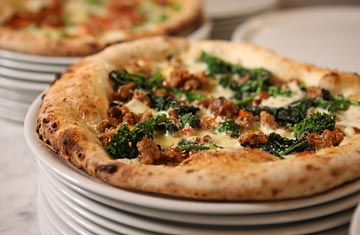
Pizza from Motorino in Williamsburg, Brooklyn.
If the rest of New York City's haute cuisine scene is languishing during the recession, there's at least one culinary quarter that's scaling new heights: the lowly pizzeria. From Williamsburg to the West Village, pizza parlors are going gourmet — importing real Italian chefs, embracing old-world baking techniques and using luxurious ingredients previously reserved for more conventional five-star fare.
The posh new pies are, of course, edging well beyond the typical $2-per-slice range. But even at the fanciest pizzerias, this glammed-up Gotham classic offers more value — and sheer fun — than most other tables in town. "Pizza is wholesome, inexpensive and always accessible," says Bob Giraldi, owner of Tonda Pizzeria in the East Village. "Perhaps that's why it is so appropriate for this particular economic moment." (See 10 things to do in New York City.)
Conversation in Italian flows as freely as the tomato sauce at Tonda, where Neapolitan chef Michele Sceral — whose family has been firing pizza for more than a century — bakes his pies in a revolving, wood-burning, $30,000 oven heated to nearly 1,000 degrees. Giraldi says his goal with Tonda is to elevate pizza from "the merely good, to the truly great." Sceral's individually portioned results include pies loaded with curious combos including roasted eggs, speck, asparagus, mozzarella and tomatoes ($15) and a carb-loaded potato, pesto and string bean pie ($14).
But Manhattan's most ambitious new player has to be Co. (pronounced "company") in Chelsea, whose crisp white tables and pale wood-paneled interior serve as a modern palette for an equally contemporary menu. Partially owned by celebrity chef Jean-Georges Vongerichten, Co., located in the Chelsea neighborhood, owes its true buzz — and bona fides — to chef Jim Lahey, who owns the beloved Sullivan Street Bakery, a New York City institution.
At Co., Lahey trades his usual loaves for crust — round, thin and fired in a 900-degree oven like they're done in Naples, occasionally charred and consistently topped with surprises. The Flambé, for instance, oozes richly with mozzarella, parmesan, caramelized onions and fatty lardons — swimming in a shallow sea of béchamel sauce ($16). Less liquid, is the Stracciatella, piled high with arugula, crushed tomatoes and its namesake cheese, and dusted with a fine coat of freshly ground black pepper ($17). And the aptly-named Popeye pie is another cheese-intensive endeavor, with ample fresh spinach atop a pecorino, gruyere and mozzarella base ($17).
"We're taking pizza back to its roots," declares Mathieu Palombino, chef-owner of another Neopolitan-inspired pizzeria, Motorino, which opened within weeks of Co. last fall, in the Williamsburg section of Brooklyn — "a place for big ideas and small budgets," he says. A Belgian-born Italian, Palombino trained in some of New York's most discerning kitchens — Bouley and BLT Fish (where he earned a Michelin star) — before learning to make pies with Verace Pizza Napoletana Americas, a California-based training institute, international certification body and the official U.S. representative of the original, authentic Naples pizza.
At Motorino, the chef is mixing the old (a classic wood-fired oven) with the newfangled: toppings such as sweet peas and guanciale ($14) or brussels sprouts with speck ($14). "Forty percent of our diners still order the classic Margherita," Palombino concedes. "Which is why we focus on the best basics — crushing our own tomatoes, making our own mozzarella, using the highest-quality flour for our dough. It's all very old school."
Across the bridge, near Grand Central Station, the brand-new Golosi (Italian for "gluttons"), which opened in April, serves pizza along with its most beloved Italian cousin, gelato, in 28 house-made flavors — including the creamy, addictive nutella. The pizza "pies" are shaped like small surfboards, with crusts mixed from imported Neapolitan flour and sinful strutto, a rendered pork fat. Once sauced and baked, they're sold by the inch — 99 cents to $1.50 per inch, three-inch minimum. Early hits include the mozzarella-only Biancaneve.
At the weeks-old Keste Pizza and Vino in the West Village, easily the most orthodox of the city's new pizzerias, there are no distracting desserts — just old-fashioned pizza and wine. Owner Roberto Caporuscio is not merely a chef — he's the president of the American chapter of the Associazone Pizzaiouli Napoletana, which trains and certifies master pizza-makers. Unsurprisingly, Keste's pizzas are all-Italian — tomatoes, cheeses and flour from the homeland, slid for a minute each into a 1,000-degree volcanic stone oven. There are 18 Keste pies in all — including the Keste, a proscuitto-loaded extravaganza doused with extra virgin olive oil ($18).
For the moment, Caporuscio is keeping his eye on the pies, but ultimately plans to offer 10-day, $4,000 pie-making courses for up-and-coming pizzaiouli. But until then, you'll have to make do with just being a customer of these new pizza pleasure dome, whose imagination and technique might actually outshine the competition back in Naples. "There are no shortcuts at work here," says Motorino's Palombino. "Pizza is now a far more serious food than it was in the past."
